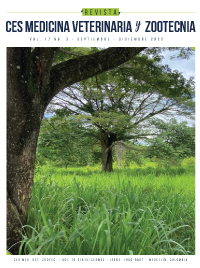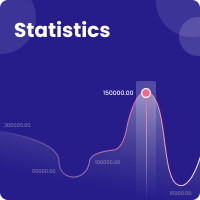Exploring an inbreeding control system using insemination bulls in closed production systems without pedigrees
DOI:
https://doi.org/10.21615/cesmvz.6980Keywords:
artificial insemination, inbreeding, inbreeding depression, genealogical recordAbstract
If an average consanguinity (F), threshold is exceeded (about 6.25%) in an animal production system, a series of anomalies may begin to appear, such as the appearance of autosomal recessive diseases, a decrease in the immune response capacity and in the productive and reproductive averages of the herds, a phenomenon known as inbreeding depression. This problem can be magnified in production systems in which genetic improvement is carried out through artificial insemination (IA by its acronym in Spanish), since, in several countries, high degrees of family kinship between inseminations bulls belonging to the same breed have been reported. In the present study are presented the results of the simulation of a strategy for the control of inbreeding in productive herds of the Aberdeen angus breed, based on the management of genealogical records of insemination bulls. The results of this study indicate that, in theory, it is possible to implement consanguinity control programs in productive farms of beef cattle subjected to IA, through a strategy that does not depend on the existence of farm genealogical records, but on records of insemination bulls. Said strategy would depend solely on the information provided to the producers by the semen supplying companies. However, the proposed method is not applicable to breeding farms, which cannot do without genealogical records and consanguinity control that considers pairings of minimal kinship.
Downloads
References
Álvarez P, Hernández JR, y Magaña F. Efecto de consanguinidad sobre la producción láctea en vacas Holstein en el establo La Estrella, León, Gto., México. Revista Chapingo Serie Zonas Áridas. 2010; 9:71-75.
American Angus Association. [acceso junio y julio de 2018].URL: http://www.angus.org.
Bezdíček J, Louda F. Relationship between inbreeding and the major histocompatibility complex: a review. Slovak J Anim Sci 2018; 51(3): 119-127
Casanova L, Hagger C, Kuenzi N, Schneeberger M. 1992. Inbreeding in Swiss Braunvieh and its influence on breeding values predicted from a repeatability animal model. J Dairy Sci 2018; 75: 1119-1126.
Cassell, B.G., V. Adamec and R.E. Pearson. Effect of incomplete pedigrees on estimates of inbreeding and inbreeding depression for days to first service and summit milk yield in Holsteins and Jerseys. J. Dairy Sci., 86: 2967-2976. 2003a.
Cassell, B.G., V. Adamec and R.E. Pearson. Maternal and fetal inbreeding depression for 70-Day nonreturnand calving rate in Holsteins and Jerseys. J. Dairy Sci., 86: 2977-2983. 2003b
Falconer D, Mackay TF. Introducción a la genética cuantitativa. 1ra ed. España. Editorial Acribia; 2001.
Florio J. Consanguinidad en la ganadería bovina. Manual de Ganadería doble propósito, 10: 129-134. 2005
Guest B. Consanguinidad en bovinos. Revista Angus Society Australia 2008; 241: 54-55.
Gutierrez JP, Goyache F. A note on ENDOG: a computer program for analyzing pedigree information. J Anim Breed Genet,122: 357-360. 2003
Meuwissen TI, y Luo Z. Computing inbreeding coefficients in large populations, Genet Sel Evol 24: 305-313. 1992.
Piñeira J y Gebauer F. 2019. Boletin 409, Instituto de Investivestigaciones Agropecuarias (INIA). Construcción y uso de registros genealógicos y productivos en bovinos y ovinos de carne. URL: https://biblioteca.inia.cl/handle/20.500.14001/6816
Piñeira J., Días M., Cancino O. Genetic relationship between insemination bulls marketed in Chile by two semen suppliers: a case study in Holstein and Angus breeds. CES Med. Vet. Zoot, 2019; 15 (2): 38-48. 2020.
Quaas RL. Computing the diagonal elements of a large numerator relationship matrix. Biometrics 32: 949-953. 1976
Servicio Agrícola y Ganadero SAG. 2020. Resolución 2987 Exenta, Fija exigencias sanitarias para la internación a chile de bovinos aptos para la reproducción y deroga Resolución Nº 1.487 Exenta de agosto de 1992. URL: http://www.sag.cl/sites/default/files/resolucion-2987-exenta_03-jul-2020.pdf
Smith, L.A., B.G. Cassell and R.E. Pearson. The effects of inbreeding on the lifetime performance of dairy cattle J. Dairy Sci. 81: 2729-2737. 1998.
Downloads
Published
How to Cite
Issue
Section
License
Copyright (c) 2023 CES Medicina Veterinaria y Zootecnia

This work is licensed under a Creative Commons Attribution-NonCommercial-ShareAlike 4.0 International License.
| Article metrics | |
|---|---|
| Abstract views | |
| Galley vies | |
| PDF Views | |
| HTML views | |
| Other views | |



